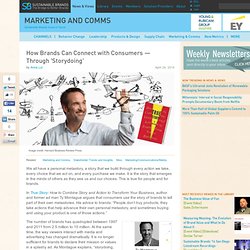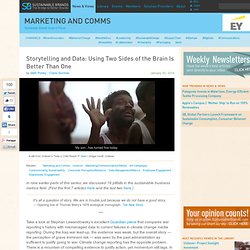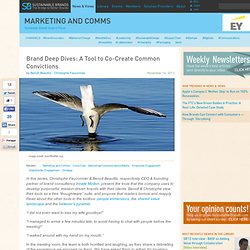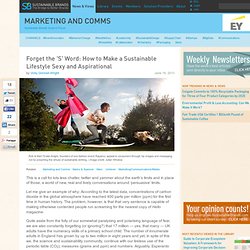

How Brands Can Connect with Consumers — Through 'Storydoing' Image credit: Harvard Business Review Press We all have a personal metastory, a story that we build through every action we take, every choice that we act on, and every purchase we make.

It is the story that emerges in the minds of others as they see us and our choices. This is true for people and for brands. In True Story: How to Combine Story and Action to Transform Your Business, author and former ad man Ty Montague argues that consumers use the story of brands to tell part of their own metastories. His advice to brands: “People don’t buy products; they take actions that help advance their own personal metastory, and sometimes buying and using your product is one of those actions.”
The number of brands has quadrupled between 1997 and 2011 from 2.5 million to 10 million. True Story introduces five critical elements — what Montague calls the “the four truths and the action map” — that are the foundation of storydoing: Storytelling and Data: Using Two Sides of the Brain Is Better Than One. A still from Unilever's "Help a Child Reach 5" video | Image credit: Unilever In nine earlier parts of this series, we discussed 19 pitfalls in the sustainable business metrics field.

(Find the first 7 articles here and the last two here.) It's all a question of story. We are in trouble just because we do not have a good story. — Opening line of Thomas Berry’s 1978 ecological monograph, The New Story Take a look at Stephan Lewandowsky’s excellent Guardian piece that compares war reporting’s history with mismanaged data to current failures in climate change media reporting. This got us thinking about how this applies to our field’s storytelling trend.
Some companies are now using storytelling, or narratives, in novel and admirable ways to inspire their employees and engage their stakeholders. Brand Deep Dives: A Tool to Co-Create Common Convictions. Image credit: eyeofthefish.org In this series, Christophe Fauconnier & Benoit Beaufils, respectively CEO & founding partner of brand consultancy Innate Motion, present the tools that the company uses to develop purposeful, mission-driven brands with their clients.

Benoit & Christophe view their tools as a free “thoughtware” suite, and propose that readers borrow and reapply. Read about the other tools in the toolbox: people immersions, the shared value landscape and the believer’s pyramid. “I did not even want to kiss my wife goodbye!” “I managed to arrive a few minutes late, to avoid having to chat with people before the meeting!” “I walked around with my hand on my mouth.” In the meeting room, the team is both horrified and laughing, as they share a debriefing of the experience we imposed on them. He pauses, and realizes the enormity of what he has just said, as we ask: “Then, why is the entire oral care category focused on cavity protection?”
They look at each other. Engineer diversity 1. Forget the 'S' Word: How to Make a Sustainable Lifestyle Sexy and Aspirational. Rob & Mart Drake-Knight, founders of eco-fashion brand Rapanui, appeal to consumers through hip images and messaging, not by preaching the virtues of sustainable clothing. | Image credit: Julian Winslow This is a call for lots less chatter, twitter and yammer about the earth’s limits and in place of those, a world of new, real and lively conversations around ‘persuasive’ limits.

Let me give an example of why: According to the latest data, concentrations of carbon dioxide in the global atmosphere have reached 400 parts per million (ppm) for the first time in human history. The problem, however, is that that very sentence is capable of making otherwise contented people run screaming for the nearest copy of Hello magazine. Quite aside from the folly of our somewhat paralysing and polarising language of fear, we are also constantly forgetting (or ignoring?) That 17 million — yes, that many — UK adults have the numeracy skills of a primary school child. It is time to wake up to our limits.
Advertising. Stop Junk Mail and Protect Against Identity Theft for Free. Psychological Marketing Business Tactics: Small Business Ideas. Risdall Marketing Pie. According to Twitter’s S-1 document, the IPO launch date is set for November 15th.

Revenue models, risks, and user base – Here is what potential investors need to know. On September 12th, Twitter officially announced that it “confidentially submitted an S-1 to the SEC for a planned IPO.” According to PrivCo, the S-1 document stated that Twitter employees can start to sell their shares on the open market as soon as Feb. 15, 2014. Newly released data shed light on the company’s planned IPO launch date, which is set for November 15th, and other crucial information. A typical lock-up period of employee stock is 90 days, meaning that a company’s employees cannot sell their stock for the first three months following an IPO. Thus, counting backwards from Feb. 15, would give an IPO launch date of around Nov. 15. Online Marketing Blog. Conversation Marketing: Internet Marketing Strategy Blog.